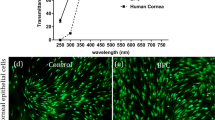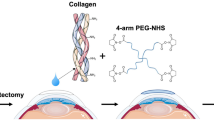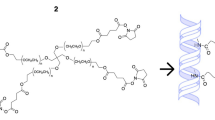Abstract
• Background
Poly(2-hydroxyethyl methacrylate) sponges are artificial tissue-equivalent matrices with potential value as materials for the peripheral zone of artificial corneas. A keratoprosthetic device was developed incorporating a poly(HEMA) spongy skirt which allowed cellular invasion. The present in vivo study investigated the biosynthetic activity of stromal fibroblasts growing within a poly(HEMA) sponge implanted into the rabbit cornea.
• Methods
A porous poly(HEMA) hydrogel was synthesized by polymerization in a large excess of water. Specimens with a pore size larger than 10 μm were impregnated with collagen type I and then implanted into the limbal region of cornea in four rabbits. The animals were followed clinically for 28 days, when they were anaesthetized and new sponge specimens were implanted in their second eye. After 2 h, both eyes were enucleated. The 28-day and 2h explants were subjected to autoradiographic analysis following labelling with tritiated proline and to an immunostaining technique using antibodies to collagen types I–VI.
• Results
The autoradiographic analysis showed that the fibroblasts within the 28-day explants continued to be synthetically active and deposited proteins. Using the immunostaining technique, the deposition was most clearly demonstrated by the localization of collagen type III in the tissue invading the sponge. Both techniques failed to indicate any cellular activity in the short-time implants.
• Conclusions
The presence of collagen type III is consistent with a normal healing response of the stromal fibroblasts and indicates that poly(HEMA) sponges are able to function as tissue-equivalent matrices.
Similar content being viewed by others
References
Ben-Zvi A, Rodrigues MM, Krachmer JH Fujikawa LS (1986) Immunohistochemical characterization of extracellular matrix in the developing human cornea. Curr Eye Res 5:105–117
Bergethon PR, Trinkaus-Randall V, Franzblau C (1989) Modified hydroxyethylmethacrylate hydrogels as a modelling tool for the study of cellsubstratum interactions. J Cell Sci 92:111–121
Bockxmeer FM van, Martin CE (1982) Measurement of cell proliferation and cell mediated contraction in 3-dimensional hydrated collagen matrices. J Tissue Cult Methods 7:163–167
Chen YC, Chirila TV, Russo AV (1993) Hydrophilic sponges based on 2-hydroxyethyl methacrylate. II. Effect of monomer mixture composition on the equilibrium water content and swelling behaviour. Mater Forum 17:57–65
Chirila TV (1994) Modern artificial corneas: the use of porous polymers. Trends Polym Sci 2:296–300
Chirila TV, Chen YC, Griffin BJ, Constable IJ (1993) Hydrophilic sponges based on 2-hydroxyethyl methacrylate. I. Effect of monomer mixture composition on the pore size. Polym International 32:221–232
Chirila TV, Constable IJ, Crawford GJ, Vijayasekaran S, Thompson DE, Chen YC, Fletcher WA (1993) Poly(2-hydroxyethyl methacrylate) sponges as implant materials: in vivo and in vitro evaluation of cellular invasion. Biomaterials 14:26–38
Chirila TV, Constable IJ, Crawford GJ, Russo AV (1994) Keratoprosthesis. US Patent 5,300,116
Chirila TV, Vijayasekaran S, Horne R, Chen YC, Dalton PD, Constable IJ, Crawford GJ (1994) Interpenetrating polymer network (IPN) as a permanent joint between the elements of a new type of artificial cornea. J Biomed Mater Res 28:745–753
Church RL (1980) Procollagen and collagen produced by normal bovine corneal stroma fibroblasts in cell culture. Invest Ophthalmol Vis Sci 19:192–202
Chvapil M, Holuša R, Kliment K, Štol M (1969) Some chemical and biological characteristics of a new collagen-polymer compound material. J Biomed Mater Res 3:315–332
Cintron C, Hong BS, Covington MI, Macarak EJ (1988) Heterogeneity of collagens in rabbit cornea: type III collagen. Invest Ophthalmol Vis Sci 29:767–775
Civerchia-Perez L, Faris B, LaPointe G, Beldekas J, Leibowitz H, Franzblau C (1980) Use of collagenhydroxyethylmethacrylate hydrogels for cell growth. Proc Natl Acad Sci USA 77:2064–2068
Crawford GJ, Constable IJ, Chirila TV, Vijayasekaran S, Thompson DE (1993) Tissue interaction with hydrogel sponges implanted in the rabbit cornea. Cornea 12:348–357
Doane KJ, Babiarz JP, Birk DE Linsenmayer TF, Birk DE (1992) Collagen fibril assembly by corneal fibroblasts in three-dimensional collagen gel cultures: small-diameter heterotypic fibrils are deposited in the absence of keratan sulfate proteoglycan. Exp Cell Res 202:113–124
Freed LE, Marquis JC, Nohria A, Emmanual J, Mikos AG, Langer R (1993) Neocartilage formation in vitro and in vivo using cells cultured on synthetic biodegradable polymers. J Biomed Mater Res 27:11–23
Freeman IL (1982) The eye. In: Weiss JB, Jayson MIV (eds) Collagen in health and disease. Churchill Livingstone, Edinburgh, pp 388–403
Girard LJ (1993) Girard keratoprosthesis with flexible skirt: 28 years experience. Refract Corneal Surg 9:194–195
Jeyanthi R, Panduranga Rao K (1990) In vivo biocompatibility of collagenpoly (hydroxyethyl methacrylate) hydrogels. Biomaterials 11:238–243
Kay EP (1988) Molecular anatomy of the vertebrate eye: distribution of collagen in ocular tissues. In: Nimni ME (ed) Collagen, vol 1: Biochemistry. CRC Press, Boca Raton, Fla, pp 207–224
Lee RE, Davison PF (1981) Collagen composition and turnover in ocular tissues of the rabbit. Exp Eye Res 32:737–745
Lee RE, Davison PF (1984) The collagens of the developing bovine cornea. Exp Eye Res 39:639–652
Legeais JM, Renard G, Salvodelli M, Keller N (1988) Etude de la colonisation tissulaire du polytetrafluoroethylene expansé en cornée saine en vue de son utilisation comme support de kératoprothése. J Fr Ophthalmol 11:727–732
Legeais JM, Renard G, Rossi C, Salvodelli M, D'Hermies F, Pouliquen Y (1991) Keratoprosthesis: a comparative study of three different microporous polymers and first application in human eyes. Invest Ophthalmol Vis Sci 32 [Suppl]:778
Legeais JM, Renard G, Pouliquen Y (1993) A novel colonizable keratoprosthesis. Refract Corneal Surg 9:205–206
LiVecchi AB, Tombes RM, LaBerge M (1994) In vitro chondrocyte collagen deposition within porous HDPE: substrate microstructure and wettability effects. J Biomed Mater Res 28:839–850
Malley DS, Steinert RF, Puliafito CA, Dobi ET (1990) Immunofluorescence study of corneal wound healing after excimer laser anterior keratectomy in the monkey eye. Arch Ophthalmol 108:1316–1322
Marinkovich MP, Rocha V (1986) Collagen synthesis and deposition during mammary epithelial cell spreading on collagen gels. J Cell Physiol 128:61–70
Marshall GE, Konstas AG, Lee WR (1991) Immunogold fine structural localization of extracellular matrix components in aged human cornea. 1. Types I–IV collagen and laminin. Graefe's Arch Clin Exp Ophthalmol 229:157–163
Marshall GE, Konstas AGP, Lee WR (1993) Collagens in ocular tissues. Br J Ophthalmol 77:515–524
Newsome DA, Foidart JM, Hassell JR, Krachmer JH, Rodrigues MM, Katz SI (1981) Detection of specific collagen types in normal and keratoconus corneas. Invest Ophthalmol Vis S620:738–750
Newsome DA, Gross J, Hassell JR (1982) Human corneal stroma contains three distinct collagens. Invest Ophthalmol Vis Sci 22:376–381
Nimni ME, Harkness RD (1988) Molecular structure and functions of collagen. In: Nimni ME (ed) Collagen, vol 1: Biochemistry. CRC Press, Boca Raton, Fla, pp 1–77
Nusgens B, Merrill C, Lapiere C, Bell E (1984) Collagen biosynthesis by cells in a tissue equivalent matrix in vitro. Collagen Rel Res 4:351–363
Olmo N, Lizarbe MA, Turnay J, Müller KP, Gavilanes JG (1988) Cell morphology, proliferation and collagen synthesis of human fibroblasts cultured on sepiolite-collagen complexes. J Biomed Mat Res 22:257–270
Py DC, DeBiccari A, Caldwell D (1993) Keratoprosthesis: engineerig and safety assessment. Refract Corneal Surg 9:206–208
Shoshan S, Gross J (1974) Biosynthesis and metabolism of collagen and its role in tissue repair processes. Israel J Med Sci 10:537–561
Štol M, Tolar M, Adam M (1985) Poly (2-bydroxyethyl methacrylate)collagen composites which promote muscle cell differentiation in vitro. Biomaterials 6:193–197
Štol M, Cifková I, Tyrácková V, Adam M (1991) Structural alterations of p(HEMA)-collagen implants. Biomaterials 12:454–460
SundarRaj N, Geiss MJ, Fantes F, Hanna K, Anderson SC, Thompson KP, Thoft RA, Waring GO (1990) Healing of excimer laser ablated monkey corneas: an immunchistochemical evaluation. Arch Ophthalmol 108:1604–1610
Tamada Y, Ikada Y (1994) Fibroblast growth on polymer surfaces and biosynthesis of collagen. J Biomed Mater Res 28:783–789
Trelstad RL, Birk DE, Silver FII (1982) Collagen fibrillogenesis in tissues, in solution and from modeling: a synthesis. J Invest Dermatol 79 [Suppl 1]:109–112
Trinkaus-Randall V, Capecchi J, Sammon L, Gibbons D, Leibowitz HM, Franzblau C (1990) In vitro evaluation of fibroblasia in a porous polymer. Invest Ophthalmol Vis Sci 31:1321–1326
Trinkaus-Randall V, Banwatt R, Capecchi J, Leibowitz HM, Franzblau C (1991) In vivo fibroplasia of a porous polymer in the cornea. Invest Ophthalmol Vis Sci 32:3245–3251
Trinkaus-Randall V, Banwatt R, Wu XY, Leibowitz HM, Franzblau C (1994) Effect of pretreating porous web on stromal fibroplasia in vivo. J Biomed Mater Res 28:195–202
Author information
Authors and Affiliations
Rights and permissions
About this article
Cite this article
Chirila, T.V., Thompson-Wallis, D.E., Crawford, G.J. et al. Production of neocollagen by cells invading hydrogel sponges implanted in the rabbit cornea. Graefe's Arch Clin Exp Ophthalmol 234, 193–198 (1996). https://doi.org/10.1007/BF00462032
Received:
Revised:
Accepted:
Issue Date:
DOI: https://doi.org/10.1007/BF00462032




